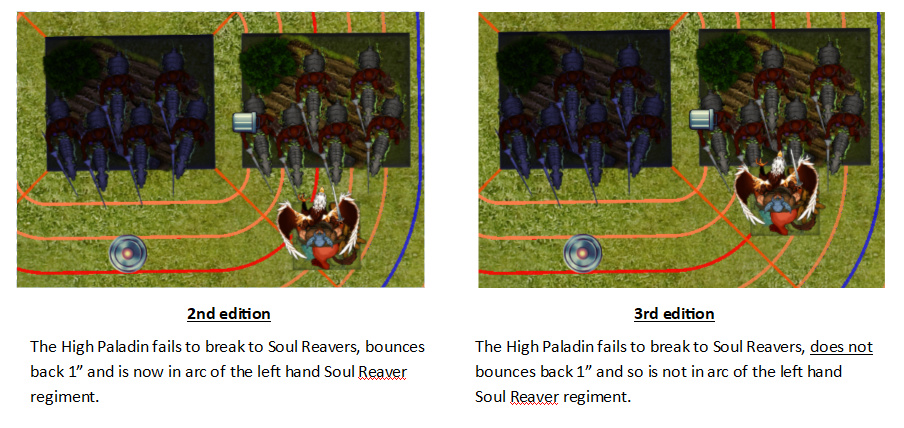Now that people have started to receive their 3rd edition books, Mantic have given the play testers permission to finally talk about version 3. Its been soooo long!
I’ve been lucky enough to have been involved in the playtesting for the last 6 months. I did a count up of all the feedback forms I’ve submitted in that time and realised that I’ve played almost 50 games of third edition! Mainly thanks to Universal Battle and being able to play against playtesters from all over the world (That averages almost two games a week… I need to get out more!).
I thought I’d share a couple of my initial thoughts and findings on 3rd edition, including where it differs from 2nd edition. This really is just scratching the surface and I have lots more a want to write, but this’ll do for a start! Just as a note to frame all of the below, I am primarily a tournament gamer. While I’m by no means a WAAC gamer, I tend to look at an army or a unit on its merits in a tournament setting.
First of all, I have to say I love V3.
I never thought that V2 was clunky or needed much changing until I played V3. Going back to V2 for tournaments in between playtesting felt like taking a massive step backwards and I see that as a real positive for the game. A lot of the things that have changed feel like quality of life upgrades rather than massive wholesale changes to the game.
No more 1” bounce backs
At the Northern Kings GT in June 2019 we held a pub quiz where the final question was “how exactly does the 1” bounce back rule work?”. Anyone who answered anything but “nobody knows” was marked as wrong. I’ve played against several members of the rules committee and heard half a dozen different ways to interpret how you should play the exact same situation. In my opinion the 1” bounce back rule was the only black mark on an otherwise slick and simple games system. So luckily, its gone!
What does this mean on the table?
Well to start with its much cleaner. You notice this straight away when there is a combat involving multiple units.
I have found that it does take some of the jeopardy out of charging. There are often situations where you would make a charge and then think “if I fail to break them and bounce back 1”, you’ll be in my flank”. This is not the case anymore and you will end up in the exact same place whether you break the enemy or not. I’ve found that this gives a slight edge to attacking units as you’re acting with perfect information. You know exactly where your unit will be at the end of the combat and there’s no chance that if the combat goes badly you’ll be pushed back 1”.
I’ve also found that you need to be much more careful to ensure that units stood side by side are properly covering each other if one is charged.
Another consequence I’ve experienced is how much more likely it makes you to be flanked after a counter charge in a combat that includes more than one unit. I’ve put a diagram below because I think it explains it better than I could in text alone.
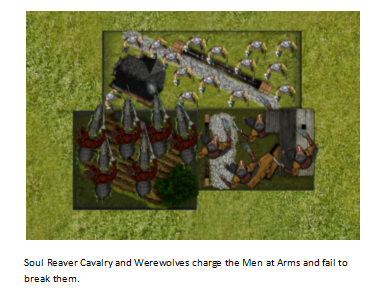
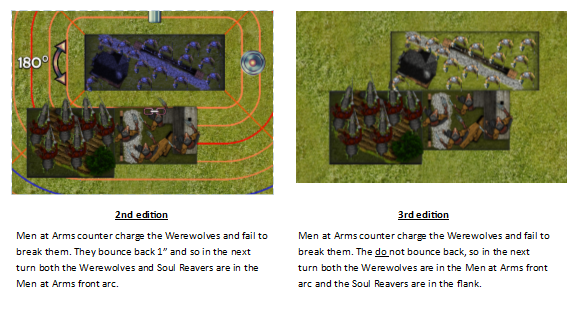
Its worth noting that the 1” bounce back is gone in all circumstances now. So for example if you choose to reform after winning a combat, its used to be that you span on the spot to where you wanted to be and then if you were closer than 1” from an enemy you were pushed back. This is no longer the case and instead the rules are now much clearer on what happens when you start your move closer than 1” from an enemy.
Overall, the removal of bounce backs feels a lot cleaner than before and I really like the change. It will take a bit of getting used to and I can see some people getting caught out to start with but I don’t think this is going to be a change that upsets anyone and after you’ve played a few games with it you’ll wonder why this wasn’t always how the game worked.
Shooting
Shooting feels like a bit of a different beast in V3. Not necessarily worse, but different.
The biggest loser in terms of shooting is the long range gunline. The lose of Ra4+ elf hordes, lots of bow carrying units either becoming irregular or 18” range (or both) and chariots shooting being very much toned down means that there aren’t many armies now that can put out enough shots beyond 18” to reliably delete entire units in one turn. Personally I say good riddance to these kind of lists. I found them boring to play with and against so I’m not bothered at all that they’re gone.
Breath weapons have also taken a hit, in that they no longer exist. Nothing in the game is now a ‘breath weapon’. Instead units that used to have breath weapons now have standard shooting attacks that are ra4+, 12” range and have steady aim. This means they can suffer from multiple penalties just like all other shooting as so can be at -3 to hit if they’re shooting at a stealthy individual in cover.
All mounted units with shooting attacks have had their range reduced to 18”, but in response most have also had a buff to their combat profile.
Several units (Heart Piercers, Gladestalkers, Corsairs etc) have gained steady aim; in my opinion these are going to be the superstar units for many armies and I can see two regiments of these steady aim shooters becoming a mainstay in many competitive army lists. Their additional maneuverability is especially valuable with the changes to how cover and terrain works (see below).
War Engines now typically have two or more shots that hit better, but do far less damage when they do hit. This means they’re more likely to do something but less likely to take units off in one go when they do hit.
I predict in V3, shooting is going to take the form of reliable chip damage rather than unit deleting batteries of fire. Don’t get me wrong you can still take units off in one go if you have enough shots, but you’ll more than likely need to be within 18” range to do that so you wont be firing with quite as much impunity as some armies are used to. The vast majority of shooting units are now also irregular so you wont be able to put anywhere near as many points into shooting.
Terrain and Cover
There are two big changes here and they both impact on shooting. During playtesting we started refer to these as soft nerfs to shooting and actually (successfully) argued that some of the more direct nerfs to shooting weren’t needed as terrain changes will have such a big impact.
Hills.
Units on hills no longer ignore intervening units of equal or less height than the hill. Instead they now just add their height to the height of the hill and work out cover as normal. This means that an infantry unit (height 2) stood on a standard size hill (height 3) will be a total height of 5. This is significant because it means anything taller than infantry will still grant cover against an infantry unit stood on a hill.
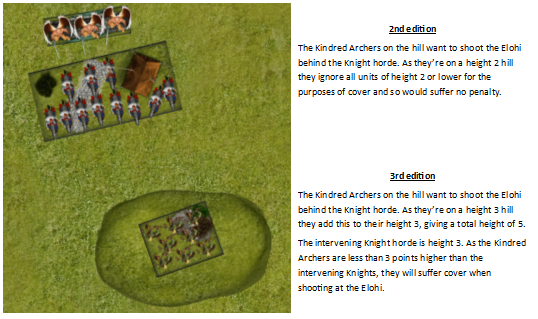
Difficult terrain.
You now no longer ignore terrain that you’re within for the purposes of cover. This means that if your leader point is within a forest, anything you target will always be in cover because its not possible to draw a line from your leader point to the enemy without it going through difficult terrain. Unless you gave the unit a hold order in the previous movement phase. In which case they can then ignore terrain they are within for the purposes of cover.
I really like this change as it makes movement and positioning even more important. You can no longer hide behind a forest in your opponents turn, walk into it during your turn and fire normally. You could still do this but if you do, you’re going to be taking cover.
A huge change for hills and difficult terrain is also how line of sight works for them. Hill and difficult terrain now work in the exact same way. I’ve done a quick diagram below to show how line of sight now works for hills. The changes to hills and LoS is actually a massive difference that will probably require a who tactics article in itself.
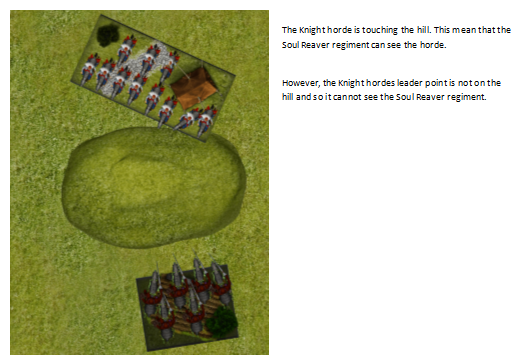
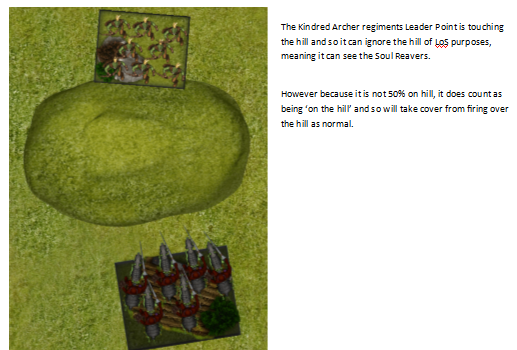
Measuring from anywhere on the front facing
In V3, charge ranges are measure from any point on the units front facing rather than just the units leader point. This has a couple of nice implications. It stops units of the same speed being able to put themselves in charge range, but stay out of range themselves and it massively opens up charge ranges for large fronted hordes. Infantry hordes feel much more dangerous than they used to and command a serious zone of control in front of themselves. From a simplicity point of view, it makes life easier because you’re not having to try and figure out exactly where a units leader point is.
I’ve found that overall this change makes the game feel faster and more aggressive. Its hard to explain but it feels like the table has shrunk by a few inches and all of your units are being pushed a little closer together, result in more frequent charges. This is compounded by the changes to hills and you’re far less likely to have your LoS blocked by a hill now that all you have to do is have your leader point on it to see through it.
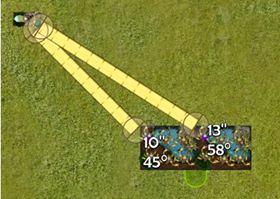
The rise and fall of individuals
Contrary to what some people might be thinking, I think V3 is going to be an Individual heavy edition, but the form and variety of the individuals we see is going to change considerably from V2.
Yielding is undoubtedly going to change the way some Individuals are played. I’m going to directly quote my fellow Northern King Nick Williams as he sums it up very succinctly (and check out his full blog article here)-
“Yielding Individuals work really well.
In most cases, it’s near impossible to block with throwaway individuals like standard bearers. If you’re too close to the enemy unit then they go right through you. If you’re closer to your unit, then they can go around you. If you do successfully block your opponent from moving through you, then you’re generally offering them an easy overrun into your flank.
A canny opponent can still do some blocking with cheap individuals, but it tends to be in conjunction with other units. Usually hitting the unit in the flank with something else to disorder it, so it can no longer move through yielding individuals.”
I completely agree with what Nick says, blocking with standard bearers and wizards is now going to be very difficult and not a strategy worth relying on. I’ll still try and do it wherever I can, but these will be the exception rather than the rule. However, a key part of the Yielding rule is that it only applies to enemy units that are not disordered. This makes combat focused individuals far more valuable than they used to be.
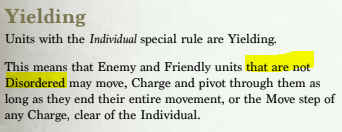
Previously, I didn’t bother taking the ‘lower level’ combat character such as Elf Princes and KoM Heroes (on horses not Pegasus!) because a mounted standard bearer was cheaper, just as good at blocking enemy units and has inspiring which is better than the 3 attacks that these characters tend to have. In V3 though I’ve found much more use for these cheaper individuals as they have a fairly decent chance of disordering the enemy and so turning themselves into roadblocks.
Just one step up from these cheap combat characters are the ‘king level’ individuals. The Basilean High Paladins and the Elf Kings. Across the board these have come down in price (the High Paladin for example has fallen by 35 points!) and importantly have the Mighty special rule. I’ve been using a High Paladin in my Basilean list for the first time in V3 and it has become a firm favourite of mine. I predict that we’ll see a lot more of these mid-tier combat characters come into use and people feel the need for Mighty or disordering character to fill in the gaps left by their now Yielding Army Standard Bearers.
Another very welcome change is the improvements made to a couple of individuals that never saw use in V2. For example the Forces of Nature Salamander Veteran was definitely a weaker choice in second edition and rarely saw play. It wasn’t that it was bad; it’s just that other units did the same job better. Now though, the Salamander Veteran has the option to take the Guiding Flame upgrade, giving itself and all friendly Salamander Prime units within 6” the Elite special rule. This gives it a powerful and unique role that can’t be filled by any other units in the list. I’ve been trying out a Salamander Veteran leading three regiments of Elite Salamander Primes and they form a really tough new core to your battle line.
I think lists will see more Individuals in more varied roles than they used to, but there will be less of a focus on both ends of the spectrum e.g the cheapest possible individuals used as blockers or the most expensive flying monsters like Bas’su’su.
These are really just the initial things that jumped out at me that I think people will notice across their first few games. I’m really excited to see how the V3 meta develops and I can’t wait to see what kind of lists people come up with.
